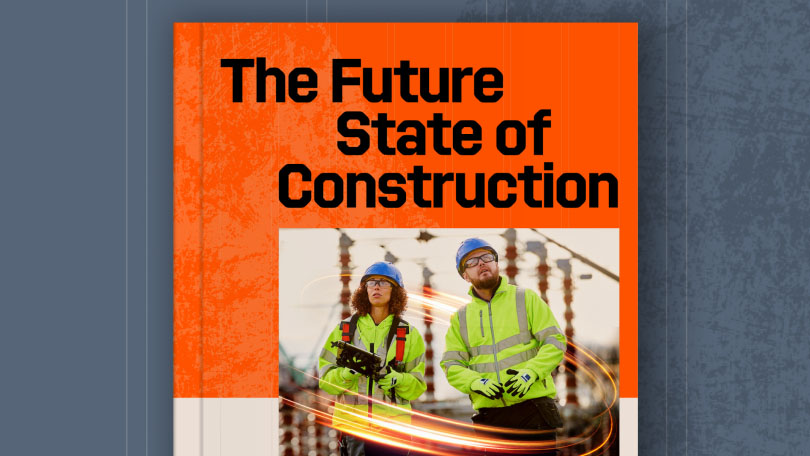— 8 min read
Construction Budgeting UK: 8 Steps to a Successful Project Budget

Last Updated Nov 24, 2025

Brendan McGurk
Strategic Product Consultant - Construction Financials
21 articles
"Brendan is a Strategic Product Consultant for Procore Financials, where he enjoys leading and innovating internal company processes to deliver on both public and private projects. He brings 12 years of experience working in various construction roles ranging from builder's hand to quantity surveyor and project manager on both the owner and main contractor side.
Originally studying Accounting, he changed direction to quantity surveying after the Christchurch Earthquake in 2011. He is now qualified and an NZIQS-recognised Quantity Surveyor. He’s since worked on projects from feasibility, concept design, and value engineering right through to construction and post-construction support.

Nicholas Dunbar
Content Manager
62 articles
Nick Dunbar oversees the creation and management of UK and Ireland educational content at Procore. Previously, he worked as a sustainability writer at the Building Research Establishment and served as a sustainability consultant within the built environment sector. Nick holds degrees in industrial sustainability and environmental sciences and lives in Camden, London.

Zoe Mullan
27 articles
Zoe Mullan is an experienced content writer and editor with a background in marketing and communications in the e-learning sector. Zoe holds an MA in English Literature and History from the University of Glasgow and a PGDip in Journalism from the University of Strathclyde and lives in Northern Ireland.
Last Updated Nov 24, 2025

A construction budget outlines projected spend on materials, labour, overheads and VAT, with a 5–10% contingency to cover unforeseen costs.
Accurate construction budgeting forms the foundation of any profitable project. It ensures resources are allocated wisely, timelines stay on track, and costly surprises are avoided. From defining project scope to adopting the latest budgeting tools, taking a systematic approach creates clarity and confidence for all stakeholders.
This guide explores the key steps, challenges and tools for building accurate budgets that set UK projects up for success.
Table of contents
Why Accurate Estimating Matters
Poor estimating practices create a cascade of problems throughout the construction process. Budget blow-outs, unrealistic expectations and disputes all stem from initial miscalculations that compound over time.
Inaccurate estimates – whether from underestimating material costs or misjudging labour requirements – can snowball into significant problems. When teams miss costs such as site preparation or material price increases, they scramble for funds or cut corners, ultimately compromising the project's quality.
Real-world Conditions Drive Success
The key to successful estimating lies in factoring in real-world conditions from the start. This means accounting for rising material prices, unpredictable site challenges and fluctuating labour costs. Accurate estimates build contingency into the budget, so no nasty mid-project surprises catch teams off guard.
Accurate estimating also sets clear expectations for stakeholders. Over-estimating can lose tenders, while under-estimating leads to mid-project frustrations when actual costs exceed projections. A reliable estimate aligns everyone – clients, suppliers and contractors – keeping the project on track both financially and operationally.
In essence, precise estimating upfront doesn't just save time and money – it builds trust and confidence. Accurate estimating proves fundamental to ensuring projects are delivered on budget, on time and to the highest standard.
How to Create a Construction Budget in the UK
A UK construction budget combines detailed take-offs, BCIS labour benchmarks and Office for National Statistics (ONS) material price data with a 5–10% contingency. It also factors in CDM 2015 duties, HSE inspections and Part L energy-efficiency upgrades to prevent compliance surprises down the line.
A solid budget starts with clarity and ends with adaptability. Nail down the project scope early, take a proper site walk to uncover hidden challenges and get detailed with material and labour needs – don't skimp on contingencies for the unexpected. And remember, your budget isn't set in stone – think of it as a living, breathing document. Review it regularly to stay ahead of surprises and keep the project on track.

Brendan McGurk
Strategic Product Consultant - Construction Financials
Procore
8 Steps for Creating a Construction Budget
Creating a solid construction budget requires a systematic approach. By breaking the process into clear steps, teams can ensure that every detail – big or small – gets accounted for, helping to minimise errors from the outset:
Define the Project Scope
Start by defining the project's scope, requirements and deliverables in detail. Ambiguity leads to underestimates, scope creep and budget overruns later in the project. Therefore, engage stakeholders early to ensure everyone understands the scope and stays aligned.
Conduct Detailed Site Visits
Next, conduct thorough site visits to uncover potential challenges that paper plans can miss. Factors such as access issues, soil quality and weather conditions could add significantly to costs, so catch them before committing to a budget. Visiting the site upfront helps avoid hidden costs such as additional groundwork or difficulties bringing heavy equipment on site.
Calculate Material Requirements
Following the site assessment, conduct a thorough material take-off – a detailed list of all materials and quantities needed – to ensure nothing gets missed. Material pricing can change quickly, especially for high-demand items like steel or timber, so lock in supplier quotes early and allow for price-shift contingencies.
- Download our RICS-aligned Bill of Quantities template to speed up take-offs.
- When estimating steel, reference BS 5950 load tables and price 250 mm UB sections accordingly.
- If the design triggers Part L 2021 upgrades, budget for higher-performance insulation and air-tightness tests – typically £8–£12/m².
- Aiming for a BREEAM "Very Good" rating? Allocate funds for low-VOC finishes and additional air-tightness verification.Secure Competitive Supplier Pricing
Once material needs are identified, contact suppliers and vendors early to get accurate pricing. Comparing quotes ensures the best value without compromising quality. Additionally, strong supplier relationships can lead to better terms and insights on material availability.
Assess Labour Requirements
With materials sorted, estimate labour costs based on project size, duration and skill requirements. Factor in productivity levels, local labour rates and contingencies for delays. Cross-check daily rates against the BCIS quarterly indices to spot abnormal spikes. Poor weather or unexpected site conditions can slow progress and increase labour costs. Building a buffer keeps your budget on track.
Factor in Overheads and Indirect Costs
Don't overlook overheads, which include equipment hire, site facilities, insurance and compliance costs. Importantly, account for permits, HSE inspections and CDM 2015 duties – skipping a £350 site-safety audit can trigger a stop-work notice and further penalties.
Build in Contingencies
Allocate a contingency – typically 5–10% or £50k–£75k (ex VAT) on a £1 million project – to handle surprises such as delays, price spikes or design changes.
Review and Refine the Budget
Finally, review the budget with the project team, refine when needed and use historical data to benchmark accuracy. Regular reviews throughout the project life cycle keep financial plans realistic and up to date.
Setting Contingency Levels
Most UK contractors carry 5–10% of the construction value as contingency. However, high-risk schemes – complex basements, inner-city refurbishments – may warrant 12–15%.
Converting Estimates into Tender Proposals
Once a solid construction budget is created, the next step involves turning it into a clear, competitive tender proposal. A well-crafted tender reflects detailed estimating work, sets client expectations and positions businesses to win the project.
Pro Tip
Position your proposal as a partnership. A clear summary upfront – covering the project's key deliverables, timeline and contingencies – reassures clients that you're not just tendering the cheapest price but providing a smart, well-thought-out solution.
Align Tender with Realistic Costs
Tenders should tell a story: here's what the project will cost and why. Break down the budget into clear, logical sections – labour, materials, overheads and contingencies – so stakeholders understand the cost structure upfront.
Avoid Over-promising and Undercutting
Competitive tendering doesn't mean racing to the bottom. Underestimating costs just to win a project leads to unhappy clients, disputes and slim (or negative) margins. Instead, present realistic numbers that account for scope, risks and real-world costs.
Highlight Value, Not Just Costs
A winning tender demonstrates where you add value:
- Clear material choices: Opt for materials that balance durability, cost and long-term savings
- Efficiency strategies: Explain how your team will stay on schedule and reduce risks like weather delays
- Realistic contingencies: Show the plan has buffers, so no mid-project surprises arise
Types of Construction Estimates
Choosing the right type of estimate proves critical to managing costs and avoiding surprises as the project progresses:
- Preliminary estimates: Early planning ball-park figures based on limited information
- Detailed estimates: Prepared once plans and site information are complete; far more precise
- Definitive estimates: The final, high-accuracy budget before execution that includes all costs and contingencies
Construction Budgeting Software Solutions
Construction budgeting software transforms how costs are managed, improves accuracy and keeps teams aligned. Platforms like Procore centralise project data and make budgeting far more efficient.
Key Benefits of Budgeting Software
- Real-time cost tracking: Monitor costs as they're incurred and reduce overruns
- Data-driven decision-making: Compare actual costs against estimates to sharpen future bids
- Simplified collaboration: cloud platforms keep project managers, clients and suppliers on the same page
- Automated reporting: Generate detailed budget reports instantly
AI-driven cost-classification can flag overspend in seconds, helping teams manage detailed costs and keep projects on budget.
Software enables teams to manage costs, down to the smallest detail, while also tracking variations and keeping records in one place is a big factor in success. This eliminates guesswork and helps projects stay on budget.

Brendan McGurk
Strategic Product Consultant - Construction Financials
Procore
Data-driven Budgeting Approach
Accurate construction budgeting isn't about gut feel – it's about leveraging data to make informed decisions:
Using Historic Data for Better Estimates
Past projects hold valuable insights. For instance, ONS data from July 2022 indicates significant year-on-year increases for materials like rebar (58.2%) – data that should inform steel allowances for future bids.
Predictive Analytics for Smarter Planning
Modern tools use predictive analytics to identify trends – like material shortages or labour fluctuations – so teams can plan contingencies well in advance.
Leveraging Technology
Tools like BIM (Building Information Modelling) let teams simulate cost and design scenarios before work begins. Combined with AI-driven software, budgeting becomes more precise, helping teams identify savings without sacrificing quality. For more, see our article on Mastering Construction Planning.
Building Confidence Through Better Budgets
Accurate construction budgeting is more than crunching numbers – it's about creating clarity, building trust and setting projects up for success. By combining detailed estimates, contingency planning and real-world insights, teams can deliver on time, on budget and to the highest standard.
Technology drives the future of budgeting, enabling smarter, data-driven decisions that help teams adapt to rising material costs, fluctuating labour markets and unexpected challenges.
In essence, a well-structured budget isn't just a financial tool – it's a blueprint for delivering value, efficiency and confidence on every project.
Frequently Asked Questions
How do you create a construction budget in the UK?
A UK construction budget combines detailed take-offs, BCIS labour benchmarks and ONS material-price data with a 5–10% contingency. It also factors in CDM 2015 duties, HSE inspections and Part L energy-efficiency upgrades.
What percentage contingency should you include?
Most UK contractors carry 5–10% of construction value as contingency; high-risk schemes may need 12–15%.
Categories:
Written by

Brendan McGurk
Strategic Product Consultant - Construction Financials | Procore
21 articles
"Brendan is a Strategic Product Consultant for Procore Financials, where he enjoys leading and innovating internal company processes to deliver on both public and private projects. He brings 12 years of experience working in various construction roles ranging from builder's hand to quantity surveyor and project manager on both the owner and main contractor side.
Originally studying Accounting, he changed direction to quantity surveying after the Christchurch Earthquake in 2011. He is now qualified and an NZIQS-recognised Quantity Surveyor. He’s since worked on projects from feasibility, concept design, and value engineering right through to construction and post-construction support.
Reviewed by

Nicholas Dunbar
Content Manager | Procore
62 articles
Nick Dunbar oversees the creation and management of UK and Ireland educational content at Procore. Previously, he worked as a sustainability writer at the Building Research Establishment and served as a sustainability consultant within the built environment sector. Nick holds degrees in industrial sustainability and environmental sciences and lives in Camden, London.
View profile
Zoe Mullan
27 articles
Zoe Mullan is an experienced content writer and editor with a background in marketing and communications in the e-learning sector. Zoe holds an MA in English Literature and History from the University of Glasgow and a PGDip in Journalism from the University of Strathclyde and lives in Northern Ireland.
View profileExplore more helpful resources

Construction Management Contracts: A Complete UK Guide
Managing construction contracts can lead to an extensive physical paper trail. Sharing contracts, getting signatures and managing timelines is difficult when teams and clients are scattered across job sites and...

Key Differences Between Contractors & Subcontractors
In UK commercial construction, main (or principal) contractors engage directly with project owners to deliver complete construction programmes, while subcontractors perform specific scopes of work under the main contractor’s management....

The Role of RFPs in UK Construction Projects
Requests for Proposals (RFPs) are a core document for construction procurement in the United Kingdom. Effective RFPs align expectations, establish clear evaluation criteria, and create accountability between clients and contractors....

Financial Management in Construction Projects
Effective financial management can make or break construction projects. Teams that master budgeting, cash flow and cost control are better positioned to deliver projects on time, within budget and with...
